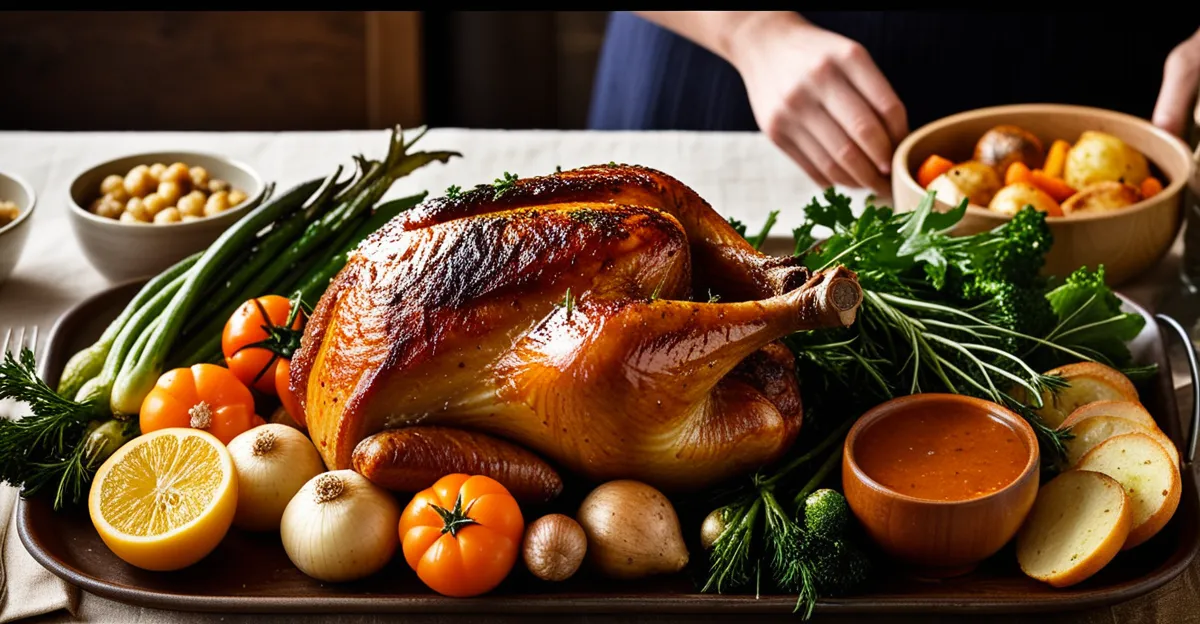Best Seasonal Vegetables to Enhance Your Roast Dinner
Choosing the right seasonal vegetables for roast dinner not only boosts flavor but also ensures the freshest ingredients. In spring, consider tender asparagus, peas, and new potatoes. These offer a light, crisp contrast to richer meats. During summer, vibrant sweetcorn, courgettes, and tomatoes shine, adding sweetness and color to your roast dinner vegetables.
Autumn brings hearty options like butternut squash, carrots, and parsnips, perfect for roasting to caramelized perfection. In winter, root vegetables such as turnips, swedes, and Brussels sprouts create a comforting, earthy base for your meal.
This might interest you : What are the best tips for baking a moist Victoria sponge cake?
When selecting seasonal produce, look for firm, unblemished vegetables with vibrant colors and fresh aromas — these indicators signal peak freshness and nutritional value.
Opting for seasonal vegetables enhances taste, supports sustainability, and often offers better value. Their natural growing cycle means they are more nutrient-rich and flavorful, making your roast dinner vegetables truly exceptional. Incorporating such produce helps create a more dynamic and balanced dish that respects both tradition and nature’s rhythm.
Have you seen this : What are the essential spices for an authentic chicken tikka masala?
Preparation and Cooking Techniques for Maximum Flavor
Mastering the art of preparing roast vegetables is crucial to unlocking their full potential. When cooking seasonal vegetables for your roast dinner, consider roasting, steaming, or glazing depending on the vegetable’s texture and flavor profile. For example, root vegetables like carrots and parsnips roast beautifully when tossed with oil and herbs, yielding caramelized edges and enhanced sweetness. Meanwhile, delicate vegetables such as asparagus or peas benefit from light steaming to preserve their brightness and tenderness.
Timing plays a vital role in roast dinner preparation. Stubborn vegetables like potatoes need longer cooking times, so they should go in the oven first. Softer vegetables or those with higher water content can be added later to prevent overcooking. This approach ensures all components arrive at the table perfectly cooked.
To elevate flavors while maintaining tradition, try glazing vegetables with a splash of honey or balsamic vinegar towards the end of roasting. This adds a subtle gloss and depth without overpowering familiar tastes. Incorporating fresh herbs such as rosemary or thyme during cooking also brings out the natural aroma of seasonal vegetables for roast dinner, enhancing the overall experience.
Creative Ways to Incorporate Seasonal Vegetables into Classic Roast Dinners
Incorporating seasonal produce into your classic roast dinner offers a fresh twist while honoring tradition. One simple way is to prepare vegetable side dishes that complement the main meat without overwhelming it. Try roasting butternut squash cubes with sage in autumn, or glazing carrots and parsnips for winter’s heartier meals. Purees made from seasonal vegetables like sweet peas in spring or roasted cauliflower in winter provide a smooth, elegant alternative that blends seamlessly on the plate.
Stuffings and gratins are another creative path for using seasonal vegetables for roast dinner. For example, a courgette and herb stuffing can bring summer’s freshness inside chicken, while a layered potato and leek gratin adds creamy texture to a Sunday roast. These methods maintain the familiar comforts of a roast dinner while introducing new dimensions of flavor and color.
By thoughtfully incorporating seasonal produce, you create more variety without losing the essence of a roast dinner. The key lies in balancing traditional tastes with subtle innovations, ensuring your roast dinner vegetables excite and satisfy every time.
Flavor Pairing Tips for Seasonal Vegetables and Roast Meats
Pairing the right seasonal vegetables for roast dinner with various meats elevates your meal beyond the ordinary. For beef roasts, robust vegetables like roasted carrots, parsnips, and Brussels sprouts complement the meat’s rich flavors. These roast dinner accompaniments benefit from herbs such as rosemary and thyme, which enhance depth without overpowering.
With chicken roasts, lighter-seasonal produce like asparagus, peas, and courgettes pairs beautifully. Their gentle flavors balance chicken’s mildness, while a squeeze of lemon or a drizzle of honey glaze brightens the dish. For pork, sweet vegetables like butternut squash or glazed carrots bring out the meat’s natural sweetness, often enhanced by warming spices like cinnamon or nutmeg.
Lamb pairs excellently with earthy roast dinner vegetables such as turnips and swedes. Mint or garlic-infused sauces amplify the combination, creating harmony between the lamb and seasonal produce.
When combining these flavors, consider textures too: crunchy roasted vegetables contrast well with tender meat, while silky purees add elegance. Experimentation with herbs, spices, and sauces tailored to seasonal vegetables for roast dinner ensures a balanced, flavorful plate that honors tradition while inviting new tastes.
Step-by-Step Guidance: Assembling a Roast Dinner with Seasonal Vegetables
Planning your roast dinner step-by-step starts with selecting the right seasonal vegetables for roast dinner. Begin by washing and prepping each vegetable according to its cooking needs—root vegetables often require peeling and dicing, whereas tender greens might just need trimming. This ensures even roasting and consistent texture.
When deciding how to make roast with vegetables, arrange denser roast dinner vegetables like potatoes and carrots in the roasting tray first, as they need more time to cook. Add quicker-cooking vegetables later, preventing overcooking and allowing everything to finish simultaneously. This strategy helps maintain each vegetable’s ideal texture and flavour.
During roast dinner preparation, use herbs and glazes applied at specific times to maximize freshness. For example, brush honey or balsamic glaze near the end to avoid burning, enhancing the natural sweetness. Keep stirring or turning vegetables halfway through cooking to encourage even caramelization.
Finally, when assembling your plate, balance colors and textures to make the meal visually appealing. Position the roasted seasonal produce alongside the meat and gravy, creating a harmonious, inviting feast that celebrates every element thoughtfully.





